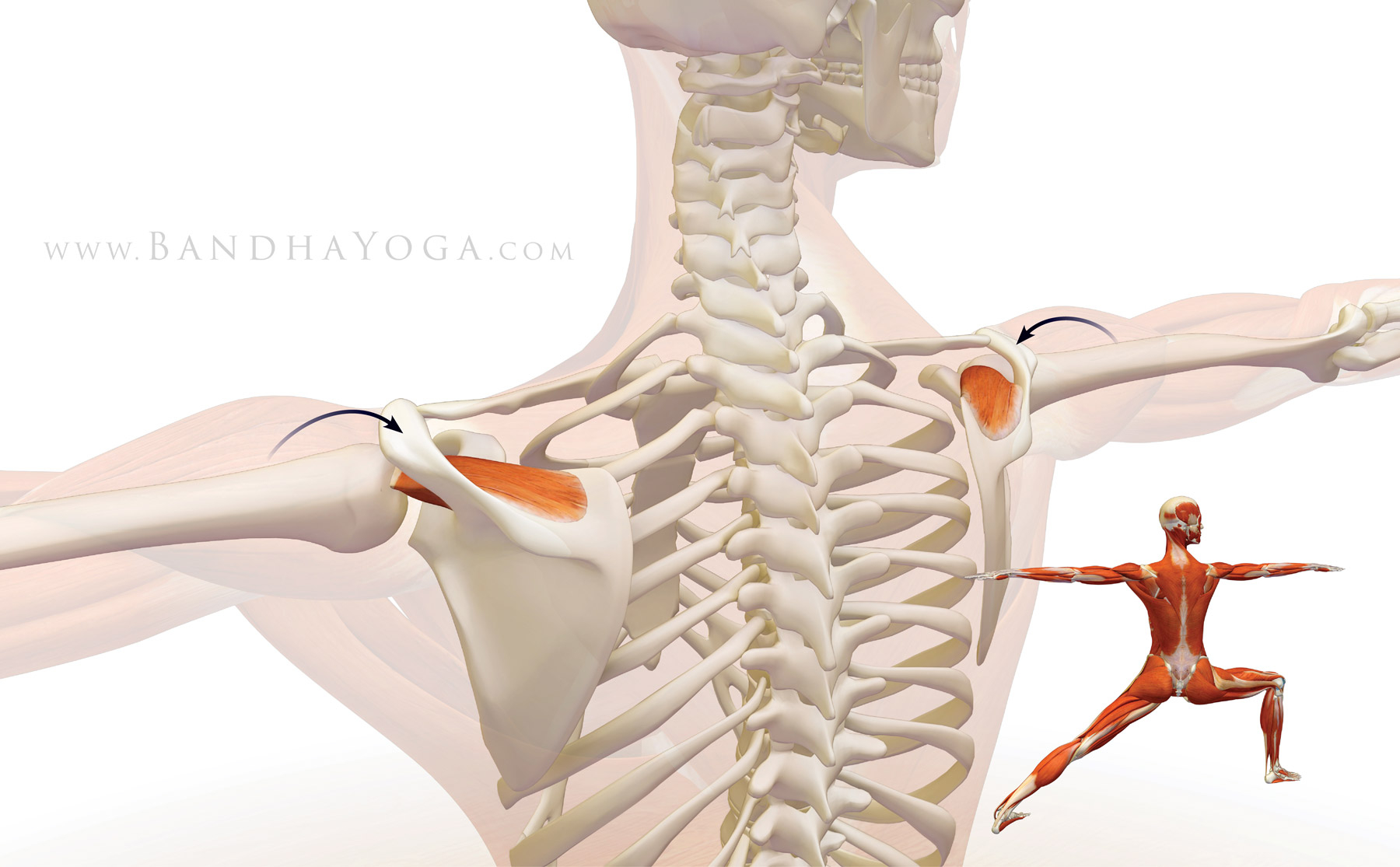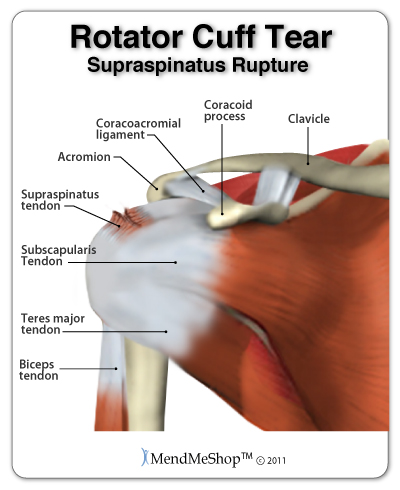
Shoulders are strong yet vulnerable parts of our bodies. Pain at the outer top tip of the shoulders is prevalent and often happens through minor injuries or overuse from everyday movements, such as bracing a fall or moving things on high shelves. Incorrect alignment in yoga poses can also aggravate such problems. Though shoulder anatomy is built to prevent such pain, bad posture and habits of movement can exacerbate wear and tear of shoulders, causing recurrent aching pain in the upper, outermost shoulder.
 Though pain in this area seems like it is coming from your deltoids (anterior, lateral, and posterior) at the top of your shoulders, the more likely culprit is a rotator cuff injury. The rotator cuff consists of 4 muscular components (subscapularis, supraspinatus, infraspinatus, and teres minor). It surrounds the head of the humerus bone, and its function is to stabilize the humerus within the ball-and-socket shoulder joint, the most mobile joint in the body. This mobility is also why this joint is the most prone to injury; learning to consciously stabilize it helps prevent dislocation and other problems. The muscles of the rotator cuff are located deep within the body, under the deltoids, so it is sometimes difficult to isolate their sensations and consciously strengthen these muscles. This is where the increased body awareness created by yoga practice is a great help.
Though pain in this area seems like it is coming from your deltoids (anterior, lateral, and posterior) at the top of your shoulders, the more likely culprit is a rotator cuff injury. The rotator cuff consists of 4 muscular components (subscapularis, supraspinatus, infraspinatus, and teres minor). It surrounds the head of the humerus bone, and its function is to stabilize the humerus within the ball-and-socket shoulder joint, the most mobile joint in the body. This mobility is also why this joint is the most prone to injury; learning to consciously stabilize it helps prevent dislocation and other problems. The muscles of the rotator cuff are located deep within the body, under the deltoids, so it is sometimes difficult to isolate their sensations and consciously strengthen these muscles. This is where the increased body awareness created by yoga practice is a great help.

Supraspinatus Muscle of the Rotator Cuff. Image Source: http://www.dailybandha.com/2016/03/the-supraspinatus-muscle.html
Of all of these 4 muscles making up the rotator cuff, the supraspinatus is the most frequently injured, because its tendon is often pinched by the scapula, as it assists the deltoids in lifting your arms. The supraspinatus is attached to the top of the humerus, where its vulnerable tendon is about the size of a large rubber band. It is most often injured when you lift your arms from about 80 to 120 degrees, the point at which it takes over that motion from your deltoids. When doing postures such as adho mukha shvanasana (Downward-facing dog) that require arm lifts in this range, do not jolt mindlessly into these poses, or do them too aggressively. Also, if you have not built the upper-body strength over time that is required in more advanced poses such as vasisthasana (Side-Plank Pose), do not do these postures yet.

Supraspinatus: Why your shoulder might ache at the outer, uppermost part. Image Source: http://www.aidyourtendon.com/tendinitis-injuries/shoulder-tendonitis/supraspinatus-tendinitis.php
Correct alignment is one of the most effective methods to protect your shoulder. In order to avoid this injury of the supraspinatus, when lifting your arms be sure to externally rotate the humerus (upper arm) and inwardly rotate the scapula. This creates space for the tendon of your supraspinatus. Make these and other subtle shifts during yoga postures, and also be aware of them during your regular daily activities. For example, typing at a keyboard or even texting often encourages your shoulders to creep up in a shrug position, making your shoulders roll slightly forward. Hence, drawing your shoulders down, back, and into your body are motions that protect your supraspinatus. This trains your deltoids to relax when you lift from 80 to 120 degrees. If they do not, the humerus bone presses against the supraspinatus and causes pinching, overexertion, and eventually pain.
 Yoga for Rotator Cuff Injury
Yoga for Rotator Cuff Injury
Luckily, unlike most things in life—or even yoga, for that matter—there might be a quick fix. Recent medical research informed by yoga poses has provided us with a technique for almost instant relief for some outer, upper shoulder pain caused by injury to the supraspinatus of the rotator cuff. In 2011, Dr. Loren Fishman discovered through his own yoga practice, and then confirmed with a clinical study, that a simple exercise called “Triangular Forearm Support (TFS)” can in most cases relieve this type of pain immediately, even before the actual injury heals. This exercise is a variation of preparatory postures for shirshasana (headstand).
Dr. Fishman explains, “The way TFS works is what happens during correct placement of the forearms and shoulder blades. The exercise, which takes only a couple of minutes, trains the subscapularis muscle to take over for the injured supraspinatus muscle in the rotator cuff.” In other words, this does not instantly heal the strained or torn tendon of the supraspinatus; instead, other rotator cuff muscles assist both the supraspinatus and the deltoids by taking over this lifting action. Even more astoundingly than instant pain relief, Dr. Fishman asserts, “Though the rotator cuff has not healed, symptoms usually almost completely disappear and do not return [emphasis added].” According to the study, regular practice (at least 2 to 3 times a week for 3 to 6 weeks) of this motion can alleviate this kind of pain for up to 2.5 years or more. Can such claims be true? Practice it for yourself and see.
 The Easy Quick Fix: How to Do Diagonal TFS Against a Wall
The Easy Quick Fix: How to Do Diagonal TFS Against a Wall
CONTRAINDICATION: If you have a torn subscapularis, do NOT do this exercise.
- Clasp your hands and bring your forearms against a wall. Your elbows should be about shoulder-height.
- Spread your elbows apart, so that the line of your forearms and clasped hands form an equilateral triangle. Your wrists should align with your forearms.
- Place the top of your head—the fontanelles, your “baby soft spot”—in the center of that triangle.
- Walk away from the wall so your torso is slanted diagonally toward the wall. Only slight weight should be on the top of your head.
NOTE: If you have neck issues and cannot put any weight on the top of you head, you can do a variation of this posture, “Downward Dog on the Wall.”
- Draw you shoulder blades back and down, while pressing your shoulders away from your ears. Be sure to press your forearms into the wall to help achieve these nuanced movements.
- Hold this position for 30 seconds.
- Move slowly away from the wall and slowly stand up straight, into Tadasana (Mountain Pose), with arms at your sides.
- Take a cleansing breath, and on your next inhale, slowly yet boldly lift your arms smoothly, taking your arms all the way up.
- Take another cleansing breath in this position, then exhale while you release your arms back down.
If you have any shoulder discomfort, be sure to alert your instructor at your next yoga class. In addition to the above exercise, it is important to rest your shoulder while it heals, so be sure to modify your usual yoga routine to avoid postures that cause discomfort, or ask your instructor for safe, beneficial modifications. Remember, your yoga practice should always be sweet and comfortable, as well as steady and strong.
See Related Posts:
Useful Link: Once you are no longer in acute pain, you can use the following gentle exercise to heal, stretch, and strengthen four muscles of the rotator cuff. It is a great motion to prevent injury. See: David Procyshyn, A Strengthening & Stretching Routine for the Rotator Cuff.
Sources:
Benjamin, C. “Rotator Cuff Problems.” Medline Plus, National Institutes of Health/U.S. National Library of Medicine. Last revised July 13, 2015. https://www.nlm.nih.gov/medlineplus/ency/article/000438.htm
Brody, Jane E. “Ancient Moves for Orthopedic Problems.” New York Times. (August 1, 2011) http://www.nytimes.com/2011/08/02/health/02brody.html?_r=0
Fishman, Loren. “A New Yoga-Inspired Technique to Help Your Shoulder Injury.” HuffPost Healthy Living. (November 22, 2011) http://www.huffingtonpost.com/loren-fishman-md/yoga-for-rotator-cuff-injury_b_916728.html
Fishman, Loren M., Wilkins, A.N., Ovadia, T., Konnoth, C., Rosner, B., Schmidhofer, S. “Yoga-Based Maneuver Effectively Treats Rotator Cuff Syndrome.” Topics in Geriatric Rehabilitation. 27.2 (April/June 2011): 51-161.
Kabel, Olga. “Want pain-free shoulders? Cut down on your downward dogs and planks.” SequenceWiz.org. (April 9, 2014) http://sequencewiz.org/2014/04/09/shoulder-problems-yoga/
Keller, Doug. “How to Avoid Shoulder Injuries in Chaturanga and Plank.” Yoga International. (June 4, 2013) https://yogainternational.com/article/view/how-to-avoid-shoulder-injuries-in-chaturanga-and-plank
Keller, Doug. “Understand and Prevent Shoulder Injuries.” Yoga International. (March 26, 2014) https://yogainternational.com/article/view/understand-and-prevent-shoulder-injuries
Laster, Judith Hanson. Yogabody: Anatomy, Kinesiology, and Asana. Berkeley, California: Rodmell Press, 2009 .
Long, Ray. The Key Muscles of Yoga (Vol. 1). New York: Bandha Yoga Publications, 2006 (org. 2005), pages 151-152 and 174-184.
Disclaimer: Always consult your healthcare provider before practicing yoga, or any other exercise program. The information provided on this website is intended for educational purposes only, and not as a substitute for medical advice or treatment. The author, illustrator, editor, and publisher assume no responsibility for injuries or harm that may result from practicing yoga or any other exercise program.


